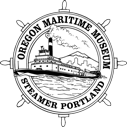PILOT HOUSE (also called the Wheelhouse)
As you arrive in the PORTLAND'S pilothouse the large wooden wheel dominates the space. It is here the captain, assisted by the marine pilot, manages the operation of the vessel. The height and views from the pilot house allow the captain control of all aspects of vessel function. The windows open for ventilation, and the captain can pick up the megaphone (in the right corner) to speak directly to the deck crew below.
The beautiful wooden wheel operates an emergency backup mechanical steering system through cables attached to the rudders in the stern. The brass column and lever in front of the wheel directs the steam powered steering unit used in normal operations. The wooden box behind the wheel contains the magnetic compass and beside that is the rudder-setting dial.
Above the wheel, a VHF radio mounted to the ceiling is within reach so that the captain can communicate with other ships on the river and notify bridge operators that we are approaching. Immediately to the right of the radio, also on the ceiling, is a small lever that operates the searchlight that illuminates the forward deck in night operations. The rope cross the ceiling operates the steam whistle. The cabin is steam heated from small tubular radiators along the forward wall.
To the starboard (right) of the wheel are the communications systems used when the vessel is operating. The brass unit mounted to the floor is the engine order telegraph (EOT). The EOT signals speed and directional information to the engineer (who stays in the engine room during a voyage). This unit is duplicated in the engineer's space to receive the captain's commands and transmit the engineer's response. Three silver levers are mounted to the starboard wall. Two of the levers transmit information on speed and direction, audibly, through a system of gongs and bells for when the engineer may be away from his EOT. The third lever signals the mate's cabin.
The black wall units contain switches for the navigational lights used in night operation. The telephone allows more detailed communication from the pilothouse to both the engineer and the fireman, at their respective workstations.
These levers and switches are duplicated on the port (left) wall serving the same communication needs as those on the starboard wall.
As you look aft (to the stern, the rear of the boat), the large black smoke stack appears to dominate the outside view. However, the captain can see the stern wheel and both sides of the vessel during operations.
